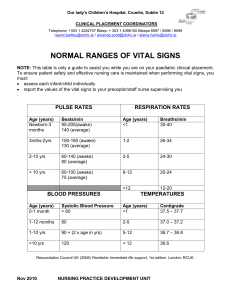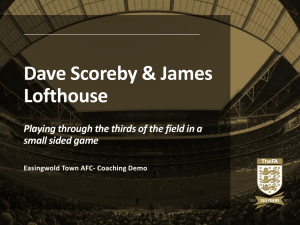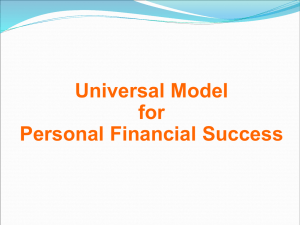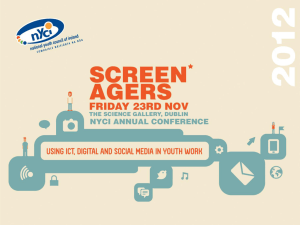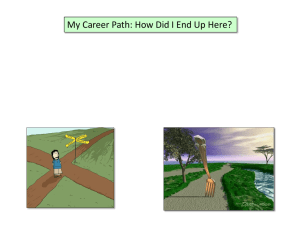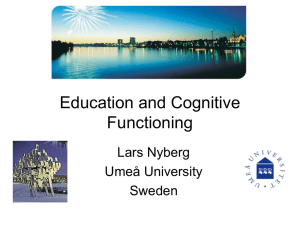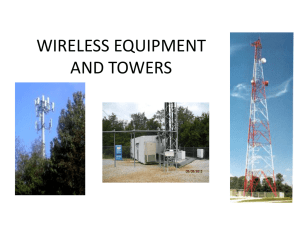PowerPoint-presentatie
advertisement
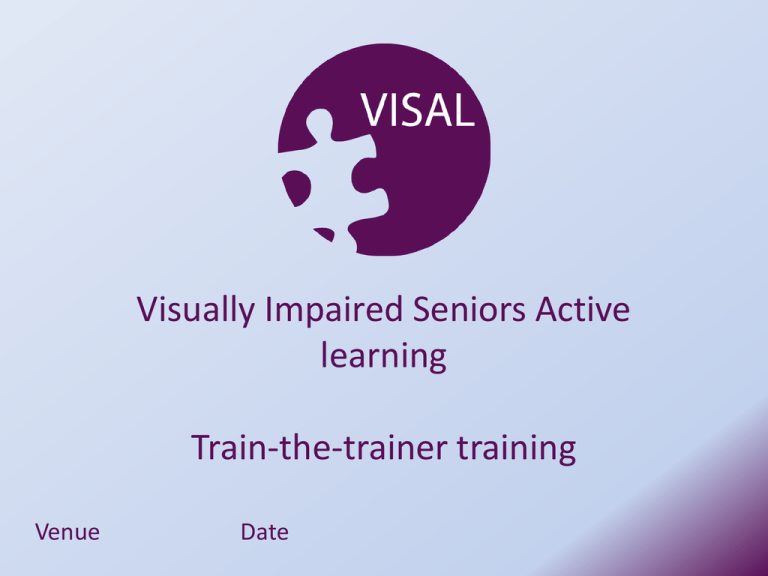
Visually Impaired Seniors Active learning Train-the-trainer training Venue Date Aims of the train-the-trainer 1. Understand the backgrounds and theories the VISAL course is based on. 2. Understand and be able to apply the sessions in a VISAL course. 3. Understand what is needed to facilitate a VISAL course. Objectives – overarching VISAL Deliver an experience to increase motivation to expand individuals influence Understand, reduce and accept barriers to participation Provide a positive experience Objectives detail of VISAL Increase skills and competences of participants, Enhance attractiveness of and access to adult learning, value the experience of blind and PS elderly persons, Increase participation and representation in civil society, increase participation within non-government organisations, especially those who respond to the needs of visual impairment and ageing communities, Combat isolation. Backgrounds • • • • • Ageing population Prevalence VI Motivation Theory of Atkinson ICF Circles of influence Backgrounds – ageing population Europe 850 million people 19 of world’s oldest countries % of population 2000 >65 yrs 14.7% >80 yrs 3% 2015 >65 yrs 17.6% >80 yrs 4.7% 2030 >65 yrs 23.5% >80 yrs 6.4% Backgrounds – population VI Prevalence visual impairment in older people: France - 60-69 yrs 3.27%, 70-79 yrs 6.01%, 80-89 yrs 15.01%, 90-99 yrs 27.86% Netherlands 1990’s – 65-74 yrs 3.1%, 7584 yrs 7.1%, 85+ yrs 24.2% UK – 1:12 by age of 60, 1:6 by age 70 Backgrounds – motivation theory Atkinson In the theory of prof J.W. Atkinson the following formula of motivation: M = P(UI+) x W K M= motivation, P(UI+) = Perception of a favourable outcome W= value for the person, K = costa or barriers Your role as a facilitator is to maximize motivation and trying in cooperation with the participants to maximize perception and value and minimize barriers. Backgrounds – ICF (International Classification of Functioning) Health Condition (Disorder or disease) Body functions & Structures Activity Participation (Limitations) (Restrictions) (Impairments) Contextual factors Environmental factors Personal factors Backgrounds – Circles of influence Decision makers Friends You Service providers Visual impairment or sight loss Exercise / Experience with blindfolds Tips and Tricks • • • Always ask them how they would like to be guided – don’t assume you know. Don’t hold the person’s arm. Let them hold your arm at the elbow, with your arm by your side. While you’re walking, keep talking to the person, telling them where you’re going and what to be aware of (for example, when you’re going up and down steps). Visual impairment or sight loss Tips and Tricks (2) • Always look back when you’re going through doorways to make sure the person is in the right position and is not going to hurt themselves. • If the person wants to sit down, allow them to manoeuvre into the chair independently, offering further verbal guidance if it looks as if they may miss the chair. Don’t push or pull people into the chair as this can be very distressing. • Always let a person know when you are leaving them, and never leave them in the middle of a room. VISAL Session Structure • • • • • • • • • Introductions Good news session Reflections on changes to previous topics Outline content/objectives Topic discussion Comfort break Exercise Summary Homework VISAL Sessions overview 1. 2. 3. 4. 5. 6. 7. Getting to know you My circles of influence Choices within the close circles Doing it together Influencing professionals and services Decision makers and influence Reflecting, evaluating and going forward VISAL Session 1 Getting to know you Aims of the session: • Understanding me the individual • To listen to others • When I listen to others they will listen to me VISAL Session 1 Getting to know you • Be committed to take what you learn back in to your everyday life and carry out small ‘home project’ tasks between sessions. • Be prepared to complete an evaluation of your experience in each workshop sessions. • Be prepared to complete a follow up evaluation three months after the sessions end. VISAL Session 1 Group rules (1) • • • • • • Be respectful Listen to each other Do not be afraid to try Everybody is entitled to their own opinion Turn up on time to sessions Turn off mobile phones VISAL Session 1 Group rules (2) • Be interested and motivated in learning new life skills • Be committed to be part of a diverse group and willing to work in an open, inclusive learning environment. • Be able to commit to attending seven learning sessions each of which will be a minimum of 2.5 hours long. VISAL Session 2 Individual and close circle Aims of the session: • Understand who is important to me • Knowing and experiencing the possibilities of being connected • Knowing there are possibilities of connection • The participant is able to determine types of relationships and would like to add to his/her your life VISAL Session 2 Most important and confronting part of this session is to fill in the circles of influence for all participants. Discussions of the results of this exercise. VISAL Session 3 Choices and influence within my close circle Aims of the session: • To know I have a choice • Positive benefits of choosing what I want • My choices are important VISAL Session 3 • Why are choices important? • Think about choices you make every day? • How are these choices limited by ageing and sight loss? • How can I change my situation ? VISAL Session 4 Doing it together – working with my peers Aims of the session: • Knowing the importance of being a member of a group & working together • Positives of belonging • You can achieve more together than on your own VISAL Session 4 • What links us? • We have things in common? • Use the ICF person model .... Shaped by the wider environment Carry similar baggage VISAL Session 5 Influencing professionals and service providers Aims of the session: • Who are the professionals or services that I can challenge? • Opportunities for help. • Can bring about real change. VISAL Session 5 • What makes bad service? Circumstances when an individual might want to challenge how they are treated when using a service • What changes the group would like to see to the listed services that would make using them easier • How does the group feel they can react to bad service? VISAL Session 6 Decision makers and influence Aims of the session: • Understanding who and how the rules are made • Finding the way through the jungle of rules • Your voice counts VISAL Session 6 • Invite a decision maker • Do an exercise that is actual and relevant for the participants • As an example you can use the exercise “Friends of the park” VISAL Session 7 Reflections evaluations and taking things forward Aims of the session: • Confirming the circle of influence • Confidence to tackle the barriers • Looking forwards to the future Practical information Recruting participants: • Start recruiting early – it will take longer than you think! • People will need time to make their decision to attend • Relate the recruitment to issues or concerns that might motivate people to get involved Practical information Choosing a venue: • Your location and venue must be accessible • Programme participants must feel safe and comfortable at the venue • Once you have identified your venue – book early as you want the programme to run in the same location for the entire length Practical information Meeting the participants prior to the programme: • You must meet and speak to the course participants before they start the first Session of the Programme • Plan the code of conduct you will want to introduce to the group • Consider the Group dynamics and the individuals attending the programme Practical information For more practical information, see the toolkit • Chapter coordinating the project • Chapter facilitating the sessions Evalution of the VISAL program For simple evaluation: see toolkit appendix 8 for evaluation forms for your VISAL program. For a more intensive evaluation proces with attention for improvement of wellbeing and engagement look for additional forms at the website: www.visal-project.eu Evalution of the train-thetrainer • Understand the VISAL Programme • Understand the role of the facilitator • Sufficient understanding of tools
